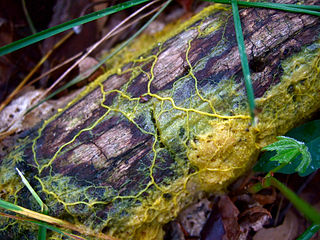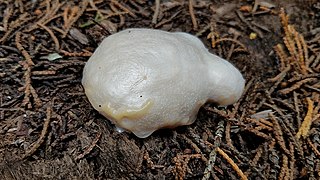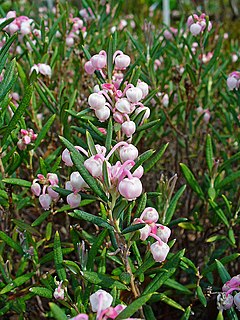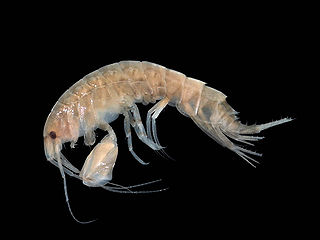
Slime mold or slime mould is an informal name given to several kinds of unrelated eukaryotic organisms that can live freely as single cells, but can aggregate together to form multicellular reproductive structures. Slime molds were formerly classified as fungi but are no longer considered part of that kingdom. Although not forming a single monophyletic clade, they are grouped within the paraphyletic group referred to as kingdom Protista.

Mycetozoa is a polyphyletic grouping of slime molds. It was originally thought to be a monophyletic clade, but recently it was discovered that protostelia are a polyletic group within Conosa.

Thallophytes are a polyphyletic group of non-motile organisms traditionally described as "thalloid plants", "relatively simple plants" or "lower plants". They form an abandoned division of kingdom Plantae that include fungi, lichens and algae and occasionally bryophytes, bacteria and slime moulds. Thallophytes have a hidden reproductive system and hence they are also incorporated into the similarly abandoned Cryptogamae, as opposed to Phanerogamae. Thallophytes are defined by having undifferentiated bodies, as opposed to cormophytes (Cormophyta) with roots and stems. Various groups of thallophytes are major contributors to marine ecosystems.

The PDSA Dickin Medal was instituted in 1943 in the United Kingdom by Maria Dickin to honour the work of animals in World War II. It is a bronze medallion, bearing the words "For Gallantry" and "We Also Serve" within a laurel wreath, carried on a ribbon of striped green, dark brown, and pale blue. It is awarded to animals that have displayed "conspicuous gallantry or devotion to duty while serving or associated with any branch of the Armed Forces or Civil Defence Units". The award is commonly referred to as "the animals' Victoria Cross".
Microbial intelligence is the intelligence shown by microorganisms. The concept encompasses complex adaptive behavior shown by single cells, and altruistic or cooperative behavior in populations of like or unlike cells mediated by chemical signalling that induces physiological or behavioral changes in cells and influences colony structures.

Physarum polycephalum, an acellular slime mold or myxomycete, is a protist with diverse cellular forms and broad geographic distribution. The “acellular” moniker derives from the plasmodial stage of the life cycle: the plasmodium is a bright yellow macroscopic multinucleate coenocyte shaped in a network of interlaced tubes. This stage of the life cycle, along with its preference for damp shady habitats, likely contributed to the original mischaracterization of the organism as a fungus. P. polycephalum is used as a model organism for research into motility, cellular differentiation, chemotaxis, cellular compatibility, and the cell cycle.

The PDSA Gold Medal is an animal bravery award that acknowledges the bravery and devotion to duty of animals. It was created by the People's Dispensary for Sick Animals (PDSA) in 2001, and is now recognised as the animal equivalent of the George Cross. The Gold Medal is considered as the civilian equivalent to PDSA's Dickin Medal for military animals. An animal can be awarded the PDSA Gold Medal if it assists in saving human or non-human life when its own life is in danger or through exceptional devotion to duty. The medal can also be awarded to animals in public service, such as police or rescue dogs, if the animal dies or suffers serious injury while carrying out its official duties in the face of armed and violent opposition.

Dame Kay Elizabeth Davies, is a British geneticist. She is Dr Lee's Professor of Anatomy at the University of Oxford and a Fellow of Hertford College, Oxford. She is director of the Medical Research Council (MRC) functional genetics unit, a governor of the Wellcome Trust, a director of the Oxford Centre for Gene Function, and a patron and Senior Member of Oxford University Scientific Society. Her research group has an international reputation for work on Duchenne muscular dystrophy (DMD). In the 1980s, she developed a test which allowed for the screening of foetuses whose mothers have a high risk of carrying DMD.
John Tyler Bonner was an American biologist who was a professor in the Department of Ecology and Evolutionary Biology at Princeton University. He was a pioneer in the use of cellular slime molds to understand evolution and development over a career of 40 years and was one of the world's leading experts on cellular slime moulds. Arizona State University says that the establishment and growth of developmental-evolutionary biology owes a great debt to the work of Bonner’s studies. His work is highly readable and unusually clearly written and his contributions have made many complicated ideas of biology accessible to a wide audience.

Lycogala epidendrum, commonly known as wolf's milk, groening's slime is a cosmopolitan species of myxogastrid amoeba which is often mistaken for a fungus. The aethalia, or fruiting bodies, occur either scattered or in groups on damp rotten wood, especially on large logs, from June to November. These aethalia are small, pink to brown cushion-like globs. They may excrete a pink paste if the outer wall is broken before maturity. When mature, the colour tends to become more brownish. When not fruiting, single celled individuals move about as very small, red amoeba-like organisms called plasmodia, masses of protoplasm that engulf bacteria, fungal and plant spores, protozoa, and particles of non-living organic matter through phagocytosis.
Each species of slime mold has its own specific chemical messenger, which are collectively referred to as acrasins. These chemicals signal that many individual cells aggregate to form a single large cell or plasmodium. One of the earliest acrasins to be identified was cAMP, found in the species Dictyostelium discoideum by Brian Shaffer, which exhibits a complex swirling-pulsating spiral pattern when forming a pseudoplasmodium.

Myxogastria/Myxogastrea or Myxomycetes (ICBN), is a class of slime molds that contains 5 orders, 14 families, 62 genera, and 888 species. They are colloquially known as the plasmodial or acellular slime moulds.

Trichiales is an order of slime moulds in the phylum Amoebozoa. Trichiales is one of five orders in the group Myxomycetes, or the true plasmodial slime molds. It is also currently categorized under the superorder Lucisporidia with its sister group, Liceales. The order was first described by Thomas MacBride in 1922, and has retained the same name and status as a defined order in present phylogeny. In the plasmodium form, members of Trichiales lack a columella but have a well-developed capillitium for spore dispersal. The shape and details of the capillitium are used to define families within the order. Spores are brightly coloured, ranging from clear, white and yellow to pink and red-brown tones. The order currently has 4 families, 14 genera and 174 species. Recent molecular research has shown that while Trichiales probably represents a true taxonomic group, its sister group Liceales is likely paraphyletic, and it has been suggested that several genera from the Liceales should be reclassified under Trichiales instead.

Enteridium lycoperdon, the false puffball, is one of the more obvious species of slime mould or Myxogastria, typically seen in its reproductive phase as a white 'swelling' on standing dead trees in the spring, or on large pieces of fallen wood. Alder is a common host.

Ireland is in the Atlantic European Province of the Circumboreal Region, a floristic region within the Holarctic.
Andrew Adamatzky is a British computer scientist, who is a Director of the Unconventional Computing Laboratory and Professor in Unconventional Computing at the Department of Computer Science and Creative Technology, University of the West of England, Bristol, United Kingdom.
Badhamia panicea is a species of slime mold in the family Physaraceae. It was first scientifically described in 1873.

Crustaceans form a large, diverse arthropod taxon which includes such animals as crabs, lobsters, crayfish, shrimps, prawns, krill, woodlice, and barnacles. The crustacean group can be treated as a subphylum under the clade Mandibulata; because of recent molecular studies it is now well accepted that the crustacean group is paraphyletic, and comprises all animals in the clade Pancrustacea other than hexapods. Some crustaceans are more closely related to insects and the other hexapods than they are to certain other crustaceans.
The concept of biological computation proposes that living organisms perform computations, and that as such, abstract ideas of information and computation may be key to understanding biology. As a field, biological computation can include the study of the systems biology computations performed by biota the design of algorithms inspired by the computational methods of biota, the design and engineering of manufactured computational devices using synthetic biology components and computer methods for the analysis of biological data, elsewhere called computational biology or bioinformatics.
Heather Barnett is an English artist and university professor working with natural phenomena and complex systems. Working with live organisms, imaging technologies and playful pedagogies, her work explores how we observe, influence and understand the world around us. Recent work centres around nonhuman intelligence, collective behaviour and distributed knowledge systems, including The Physarum Experiments, an ongoing 'collaboration' with an intelligent slime mould; Animal Collectives collaborative research with SHOAL Group at Swansea University where she is an Honorary Research Fellow; and a series of publicly sited collective bio/social experiments, including Crowd Control and Nodes and Networks. She is best known for her work with slime mould. and in 2014 gave a TED talk about slime mould. She is the founding member of SLIMOCO: The Slime Mould Collective, a group of scientists and artists who work with slime mould. She was also the 2014 "Artist-in-Restaurant" at the London restaurant Pied-a-Terre. For four years the restaurant has chosen an artist each year to spend time at the restaurant, eating and lingering in the working areas of the kitchen observing, and then to produce artworks reflecting the experience. She has exhibited at the Victoria & Albert Museum and the Science Museum, London.













